Light Weight, Flexible and Ultrathin PTFE@Ag and Ni@PVDF Composite Film for High-Efficient Electromagnetic Interference Shielding
Abstract
:1. Introduction
2. Materials and Methods
2.1. Materials
2.2. Preparation of PTFE@PDA
2.3. Preparation of PTFE@Ag
2.4. Preparation of Nickel Nanochains
2.5. Preparation of PTFE@Ag+Ni@PVDF
2.6. Performance and Characterization of Samples
3. Results and Discussions
3.1. Structure Analysis
3.2. Morphology Analysis
3.3. Performance Analysis
4. Conclusions
Author Contributions
Funding
Institutional Review Board Statement
Informed Consent Statement
Data Availability Statement
Acknowledgments
Conflicts of Interest
References
- He, Y.; Yang, J.; Chen, W.; Chen, W.; Zhao, L.; Qi, W. Gallium-doped MXene/cellulose nanofiber composite membranes with electro/photo thermal conversion property for high performance electromagnetic interference shielding. Chem. Eng. J. 2023, 464, 142565. [Google Scholar] [CrossRef]
- Lv, H.; Yang, Z.; Ong, S.J.H.; Wei, C.; Liao, H.; Xi, S.; Du, Y.; Ji, G.; Xu, Z.J. A Flexible Microwave Shield with Tunable Frequency-Transmission and Electromagnetic Compatibility. Adv. Funct. Mater. 2019, 29, 1900163. [Google Scholar] [CrossRef]
- Li, J.; Cui, M.; Wang, L.; Zhang, A.; Chen, Y.; Xiang, J.; Fan, H. Nonionic waterborne polyurethane/polypyrrole/silver nanowires coating film with high-efficient electromagnetic interference shielding. Chem. Phys. Lett. 2022, 804, 139882. [Google Scholar] [CrossRef]
- Gao, Q.; Zhang, Y.; Zhang, S.A.; Ma, Y.; Sheng, X.; Hui, L.; Wang, Z.; Yun, S.; Qin, J.; Zhang, G. Hierarchical structured epoxy/reduced graphene oxide/Ni-chains microcellular compo-site foam for high-performance electromagnetic interference shielding. Compos. Part A 2023, 170, 107536. [Google Scholar] [CrossRef]
- Yu, J.; Gu, W.; Zhao, H.; Ji, G. Lightweight, flexible and freestanding PVA/PEDOT: PSS/Ag NWs film for high-performance electromagnetic interference shielding. Sci. China Mater. 2021, 64, 1723–1732. [Google Scholar] [CrossRef]
- Liang, L.; Xu, P.; Wang, Y.; Shang, Y.; Ma, J.; Su, F.; Feng, Y.; He, C.; Wang, Y.; Liu, C. Flexible polyvinylidene fluoride film with alternating oriented graphene/Ni nanochains for electromagnetic interference shielding and thermal management. Chem. Eng. J. 2020, 395, 125209. [Google Scholar] [CrossRef]
- Li, C.; Zhang, H.; Song, Y.; Cai, L.; Wu, J.; Wu, J.; Wang, S.; Xiong, C. Robust superhydrophobic and porous melamine-formaldehyde based composites for high-performance electromagnetic interference shielding. Colloids Coll. Surfaces A Physicochem. Eng. Asp. 2021, 624, 126742. [Google Scholar] [CrossRef]
- Sun, Y.L.; Li, B.; Zheng, H.F.; Rong, K.; Fan, W.; Li, D. MXene-decorated carbonized jute composite for high-performance electromagnetic inter-ference shielding. J. Mater. Res. Tech. 2023, 22, 658–667. [Google Scholar] [CrossRef]
- Ebrahimi, I.; Gashti, M.P. Chemically reduced versus photo-reduced clay-Ag-polypyrrole ternary nanocomposites: Comparing thermal, optical, electrical and electromagnetic shielding properties. Mater. Res. Bull. 2016, 83, 96–107. [Google Scholar] [CrossRef]
- Guiderdoni, C.; Pavlenko, E.; Turq, V.; Weibel, A.; Puech, P.; Estournès, C.; Peigney, A.; Bacsa, W.; Laurent, C. The preparation of carbon nanotube (CNT)/copper composites and the effect of the number of CNT walls on their hardness, friction and wear properties. Carbon 2013, 58, 185–197. [Google Scholar] [CrossRef] [Green Version]
- Kim, H.-R.; Fujimori, K.; Kim, B.-S.; Kim, I.-S. Lightweight nanofibrous EMI shielding nanowebs prepared by electrospinning and metallization. Compos. Sci. Technol. 2012, 72, 1233–1239. [Google Scholar] [CrossRef]
- Sang, M.; Liu, G.; Liu, S.; Wu, Y.; Xuan, S.; Wang, S.; Xuan, S.; Jiang, W.; Gong, X. Flexible PTFE/MXene/PI soft electrothermal actuator with electromagnetic-interference shielding property. Chem. Eng. J. 2021, 414, 128883. [Google Scholar] [CrossRef]
- Das, A.; Hayvaci, H.T.; Tiwari, M.K.; Bayer, I.S.; Erricolo, D.; Megaridis, C.M. Superhydrophobic and conductive carbon nanofiber/PTFE composite coatings for EMI shielding. J. Colloid Coll. Interface Sci. 2011, 353, 311–315. [Google Scholar] [CrossRef] [PubMed]
- Yang, R.; Zhou, Y.Y.; Ren, Y.M.; Xu, D.; Guan, L.; Guo, X.; Zhang, R.; Zhao, B. Promising PVDF-CNT-Graphene-NiCo chains composite films with excellent electro-magnetic interference shielding performance. J. Alloys Compd. 2022, 908, 164538. [Google Scholar] [CrossRef]
- Ye, L.; Liu, L.-X.; Yin, G.; Liu, Y.; Deng, Z.; Qi, C.-Z.; Zhang, H.-B.; Yu, Z.-Z. Highly conductive, hydrophobic, and acid/alkali-resistant MXene@PVDF hollow core-shell fibers for efficient electromagnetic interference shielding and Joule heating. Mater. Today Phys. 2023, 35, 101100. [Google Scholar] [CrossRef]
- Su, Z.; Yang, H.; Wang, G.; Zhang, Y.; Zhang, J.; Lin, J.; Jia, D.; Wang, H.; Lu, Z.; Hu, P. Transparent and high-performance electromagnetic interference shielding composite film based on single-crystal graphene/hexagonal boron nitride heterostructure. J. Colloid Coll. Interface Sci. 2023, 640, 610–618. [Google Scholar] [CrossRef]
- Gao, Q.; Zhang, G.; Zhang, Y.; Fan, X.; Wang, Z.; Zhang, S.; Xiao, R.; Huang, F.; Shi, X.; Qin, J. Absorption dominated high-performance electromagnetic interference shielding epoxy/functionalized reduced graphene oxide/Ni-chains microcellular foam with asymmetric conductive structure. Compos. Sci. Technol. 2022, 223, 109419. [Google Scholar] [CrossRef]
- Kuznetsova, L.S.; Arlyapov, V.A.; Kamanina, O.A.; Lantsova, E.A.; Tarasov, S.E.; Reshetilov, A.N. Development of Nanocomposite Materials Based on Conductive Polymers for Using in Glucose Biosensor. Polymers 2022, 14, 1543. [Google Scholar] [CrossRef]
- Tan, H.; Gou, J.; Zhang, X.; Ding, L.; Wang, H. Sandwich-structured Ti3C2Tx-MXene/reduced-graphene-oxide composite membranes for high-performance electromagnetic interference and infrared shielding. J. Membr. Sci. 2023, 675, 121560. [Google Scholar] [CrossRef]
- Sambyal, P.; Iqbal, A.; Hong, J.; Kim, M.-K.; Kim, I.-D.; Koo, C.M. Conductive MXene composites with liquid metal for high-performance electromagnetic interference shielding. Mater. Chem. Phys. 2023, 295, 121560. [Google Scholar] [CrossRef]
- Zheng, X.; Tang, J.; Wang, P.; Wang, Z.; Zou, L.; Li, C. Interfused core-shell heterogeneous graphene/MXene fiber aerogel for high-performance and durable electromagnetic interference shielding. J. Colloid Interface Sci. 2022, 628, 994–1003. [Google Scholar] [CrossRef]
- Diao, J.; Yuan, J.; Cai, Z.; Xia, L.; Cheng, Z.; Liu, X.; Ma, W.; Wang, S.; Huang, Y. High-performance electromagnetic interference shielding and thermoelectric conversion derived from multifunctional Bi2Te2.7Se0.3/MXene composites. Carbon 2022, 196, 243–252. [Google Scholar] [CrossRef]
- Li, X.; Qu, Y.F.; Wang, X.; Bian, H.; Wu, W.; Dai, H. Flexible graphene/silver nanoparticles/aluminum film paper for high-performance electro-magnetic interference shielding. Mater. Des. 2022, 213, 110296. [Google Scholar] [CrossRef]
- Gao, Q.; Qin, J.B.; Guo, B.R.; Fan, X.; Wang, F.; Zhang, Y.; Xiao, R.; Huang, F.; Shi, X.; Zhang, G. XHigh-performance electromagnetic interference shielding epoxy/Ag nanowire/thermal annealed graphene aerogel composite with bicontinuous three-dimensional conductive skeleton. Compos. Part A 2021, 151, 106648. [Google Scholar] [CrossRef]
- Tao, J.; Liu, N.; Li, S.; Shi, J.; Ji, S. Structural manipulation of silver nanowire transparent conductive films for optoelectrical property optimization in different application fields. Thin Solid Films 2021, 729, 138679. [Google Scholar] [CrossRef]
- Zhang, N.; Zhao, R.; He, D.; Ma, Y.; Qiu, J.; Jin, C.; Wang, C. Lightweight and flexible Ni-Co alloy nanoparticle-coated electrospun polymer nanofiber hybrid membranes for high-performance electromagnetic interference shielding. J. Alloy. Compd. 2019, 784, 244–255. [Google Scholar] [CrossRef]
- Savchyn, V.P.; Popov, A.I.; Aksimentyeva, O.I.; Klym, H.; Horbenko, Y.Y.; Serga, V.; Moskina, A.; Karbovnyk, I. Cathodoluminescence characterization of polystyrene-BaZrO3 hybrid composites. Low Temp. Phys. 2016, 42, 597–600. [Google Scholar] [CrossRef]
- Aksimentyeva, O.I.; Savchyn, V.P.; Dyakonov, V.P.; Piechota, S.; Horbenko, Y.Y.; Opainych, I.Y.; Demchenko, P.Y.; Popov, A.; Szymczak, H. Modification of Polymer-Magnetic Nanoparticles by Luminescent and Conducting Substances. Mol. Cryst. Liq. Cryst. 2014, 590, 35–42. [Google Scholar] [CrossRef]
- Zhang, D.X.; Zhuo, L.; Xiang, Q. Electrophoretic deposition of polytetrafluoro-ethylene (PTFE) as anti-corrosion coatings. Mater. Lett. 2023, 346, 134524. [Google Scholar] [CrossRef]
- Yu, Y.; Zhang, L.; Li, X.; Ye, J.; Meng, J. Multifunctionalization of PTFE membrane surface for biofouling resistance and oil/water separation performance improvement. J. Environ. Chem. Eng. 2023, 11, 109158. [Google Scholar] [CrossRef]
- Yang, Y.; Liu, Y.-X.; Deng, B.-W.; Li, Y.; Yin, B.; Yang, M.-B. Construction of three-dimensional carbon materials-based conductive bonding network in flexible supercapacitor electrodes. Electrochim. Acta 2023, 440, 141751. [Google Scholar] [CrossRef]
- Shahkaramipour, N.; Lai, C.K.; Venna, S.R.; Sun, H.; Cheng, C.; Lin, H. Membrane Surface Modification Using Thiol-Containing Zwitterionic Polymers via Bioadhesive Polydopamine. Ind. Eng. Chem. Res. 2018, 57, 2336–2345. [Google Scholar] [CrossRef]
- Sharma, S.; Lee, J.; Dang, T.T.; Hur, S.H.; Choi, W.M.; Chung, J.S. Ultrathin freestanding PDA-Doped rGO/MWCNT composite paper for electromagnetic interference shielding applications. Chem. Eng. J. 2022, 430, 132808. [Google Scholar] [CrossRef]
- Wang, P.; Jian, M.; Wu, M.; Zhang, C.; Zhou, C.; Ling, X.; Zhang, J.; Yang, L. Highly sandwich-structured silver nanowire hybrid transparent conductive films for flexible transparent heater applications. Compos. Part A Appl. Sci. Manuf. 2022, 159, 106998. [Google Scholar] [CrossRef]
- Guo, B.Z.; Liang, J.Y.; Chen, J.F.; Zhao, Y. Highly flexible and ultrathin electromagneticinterference-shielding film with a sandwich structure based on PTFE@Cu and Ni@PVDF nanocomposite materials. RSC Adv. 2022, 12, 29688–29696. [Google Scholar] [CrossRef]
- Bo-Luo, Y.; Liu, P.; Wei, L.M.; Zhang, Y.F. Magnetic-field-induced Template-free Fabrication of Nickel Nanowires. J. Zhengzhou Univ. 2009, 41, 77–81. [Google Scholar]
- Sheng, A.; Ren, W.; Yang, Y.; Yan, D.-X.; Duan, H.; Zhao, G.; Liu, Y.; Li, Z.-M. Multilayer WPU conductive composites with controllable electro-magnetic gradient for absorption-dominated electromagnetic interference shielding. Compos. Part A Appl. Sci. Manuf. 2020, 129, 105692. [Google Scholar] [CrossRef]
- Zeng, Z.; Jiang, F.; Yue, Y.; Han, D.; Lin, L.; Zhao, S.; Pan, Z.; Li, C.; Nyström, G.; Wang, J. Flexible and Ultrathin Waterproof Cellular Membranes Based on High-Conjunction Met-al-Wrapped Polymer Nanofibers for Electromagnetic Interference Shielding. Adv. Mater. 2020, 32, 1908496. [Google Scholar] [CrossRef]
- Zhang, W.Z.; Liu, D.R.; Quan, C.B.; Qiu, X.L. Research progress of ployimide-basedelectro magnetic shielding material. New Chem. Mater. 2020, 48, 10–14. [Google Scholar]

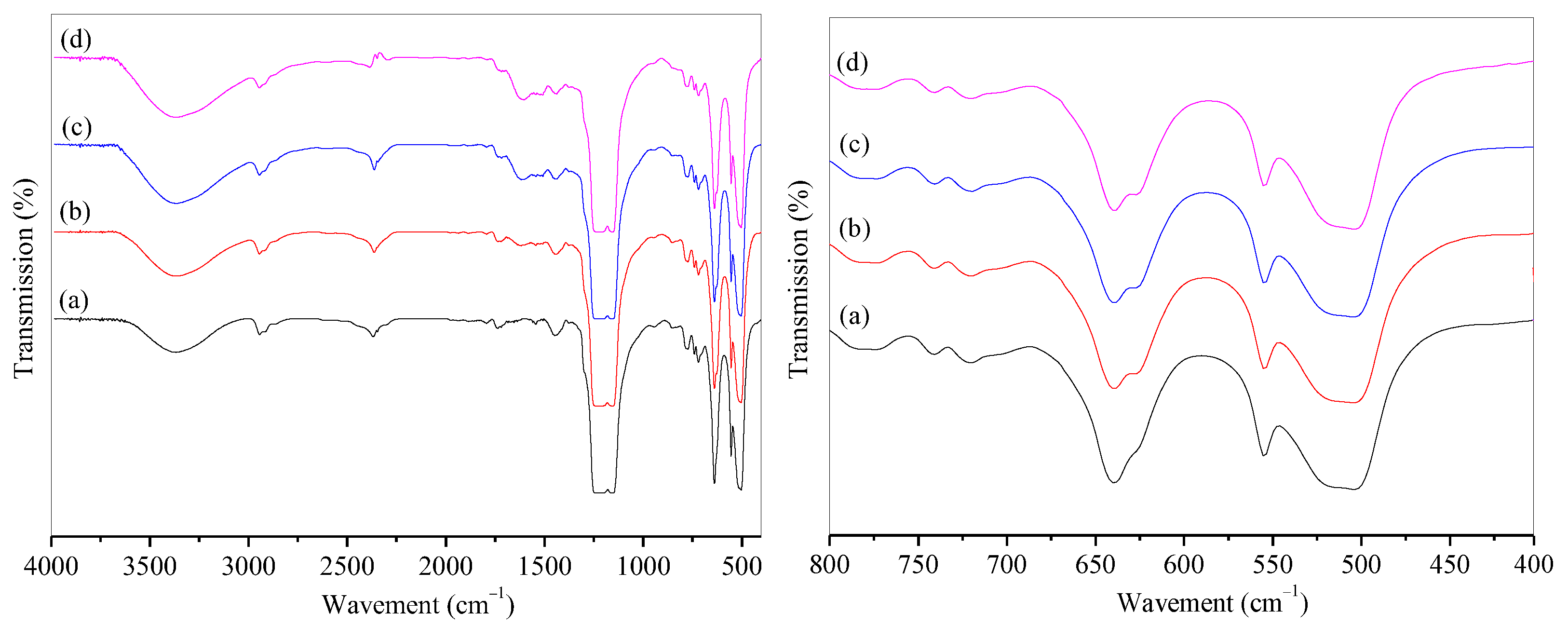
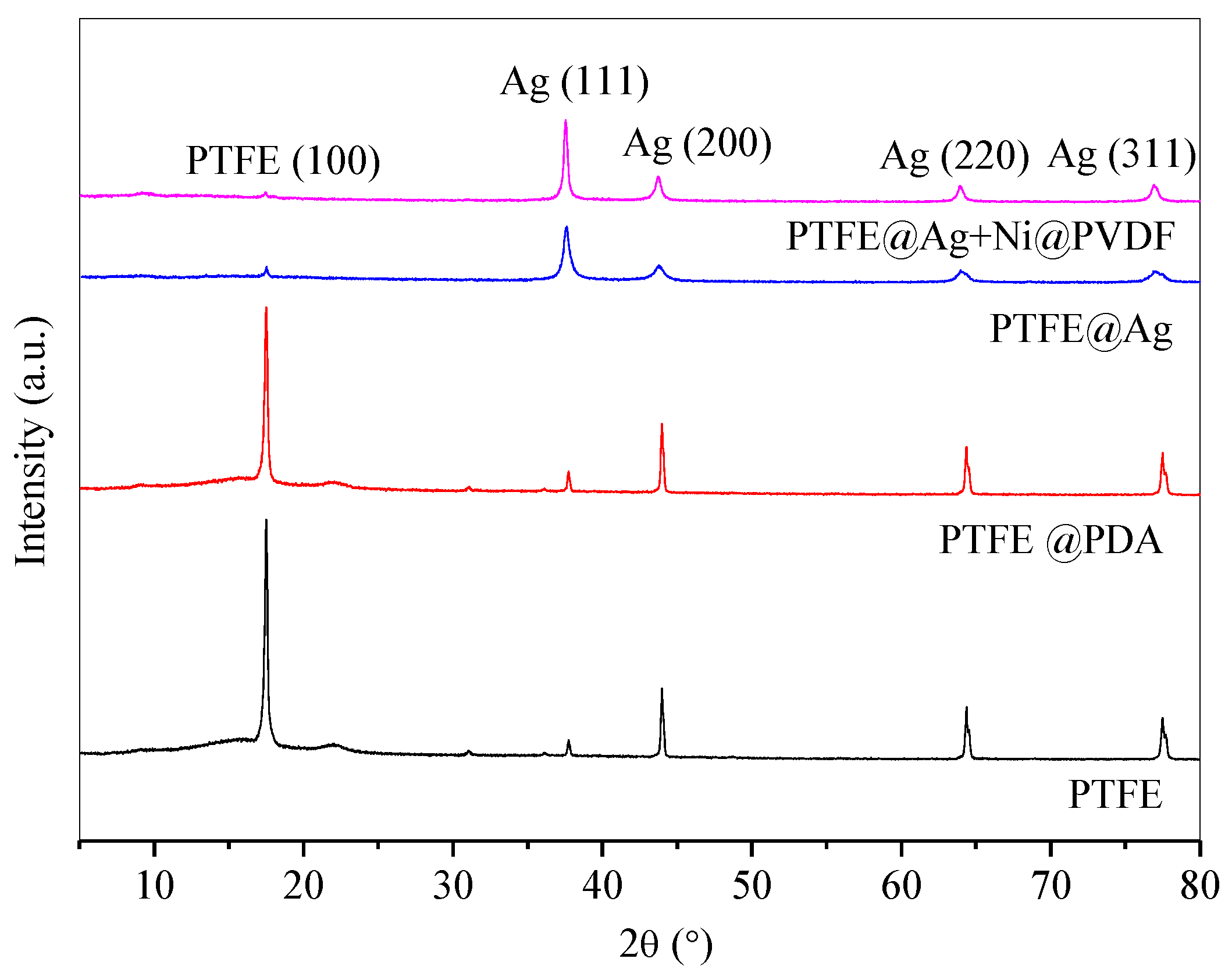

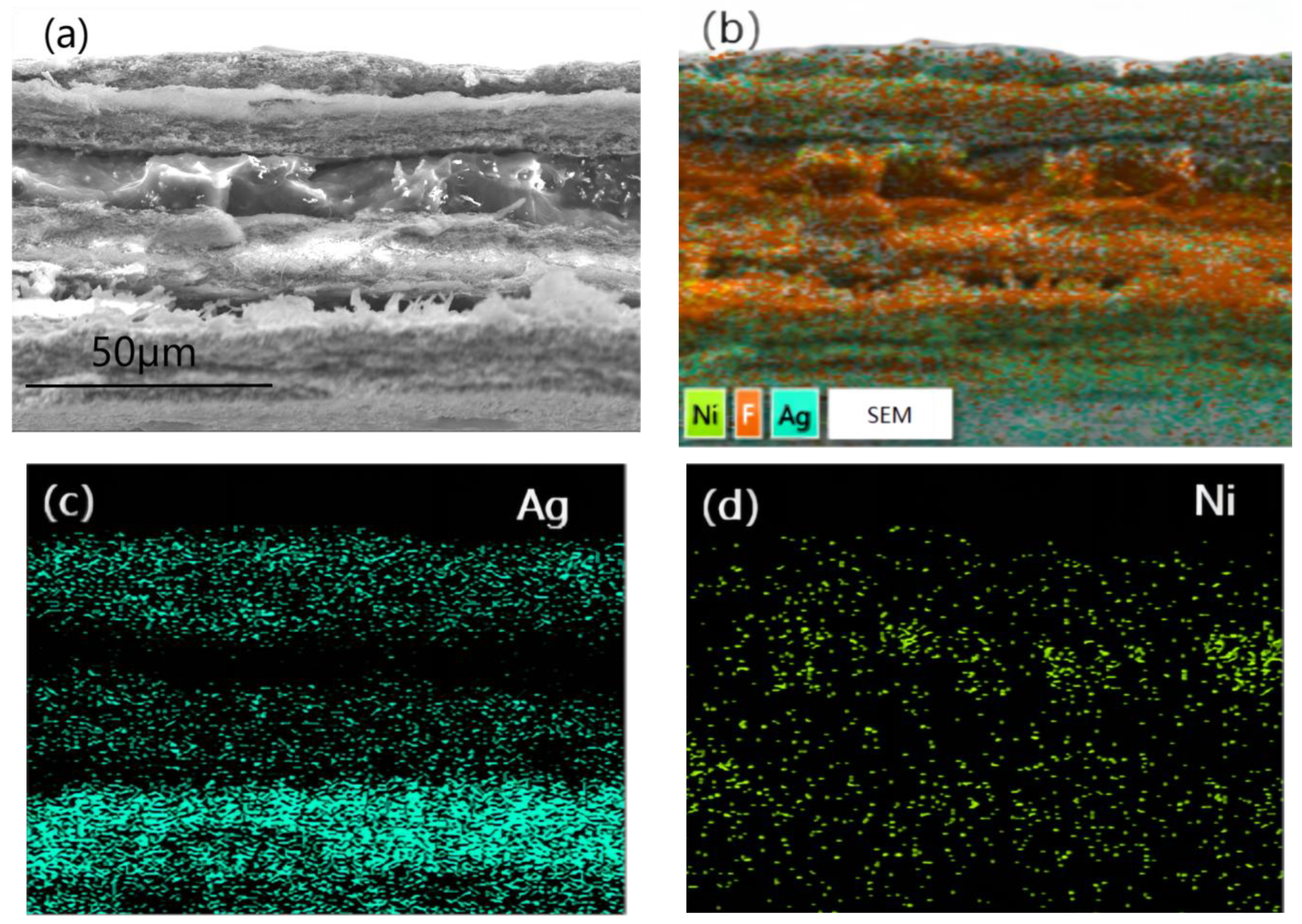
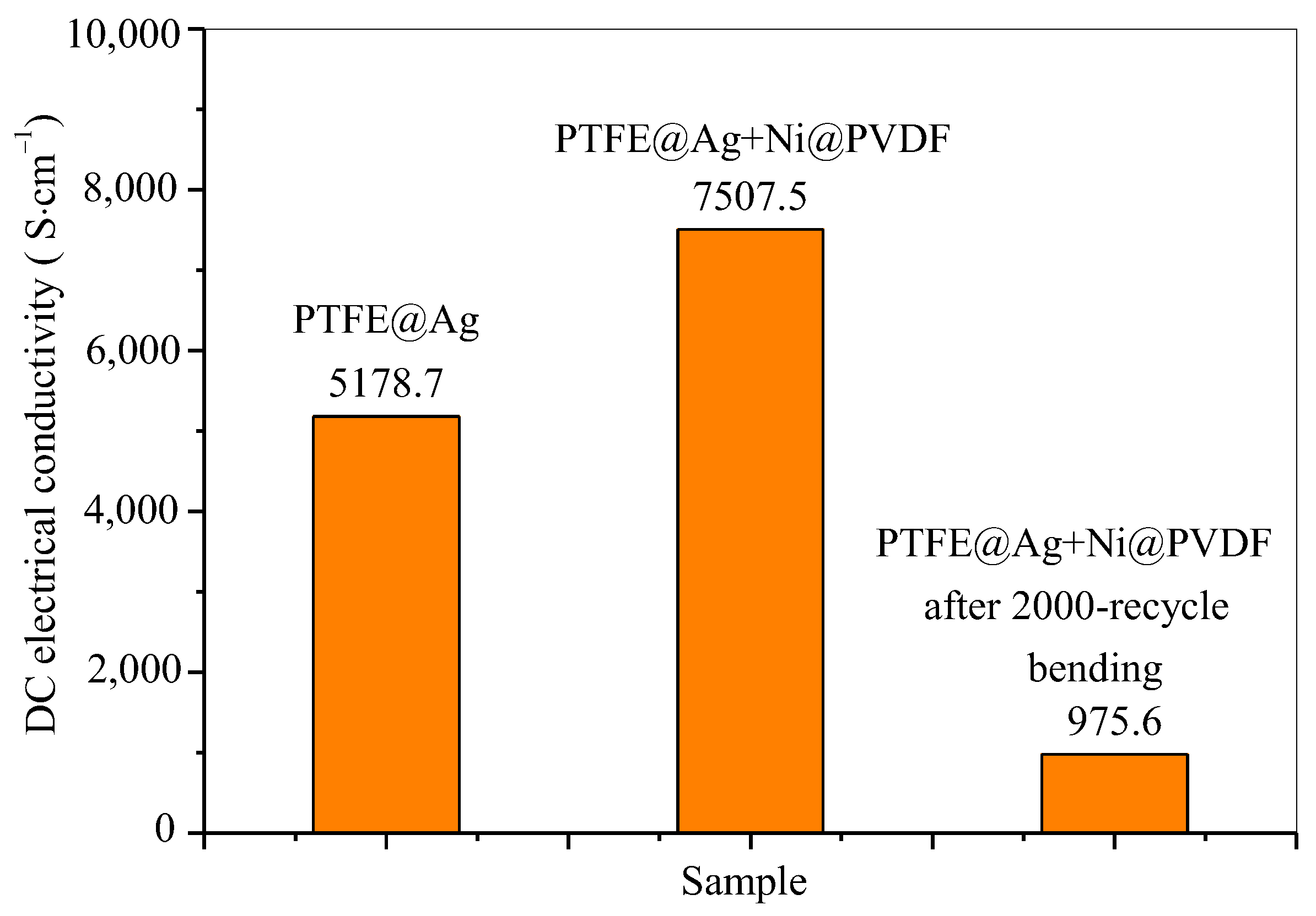

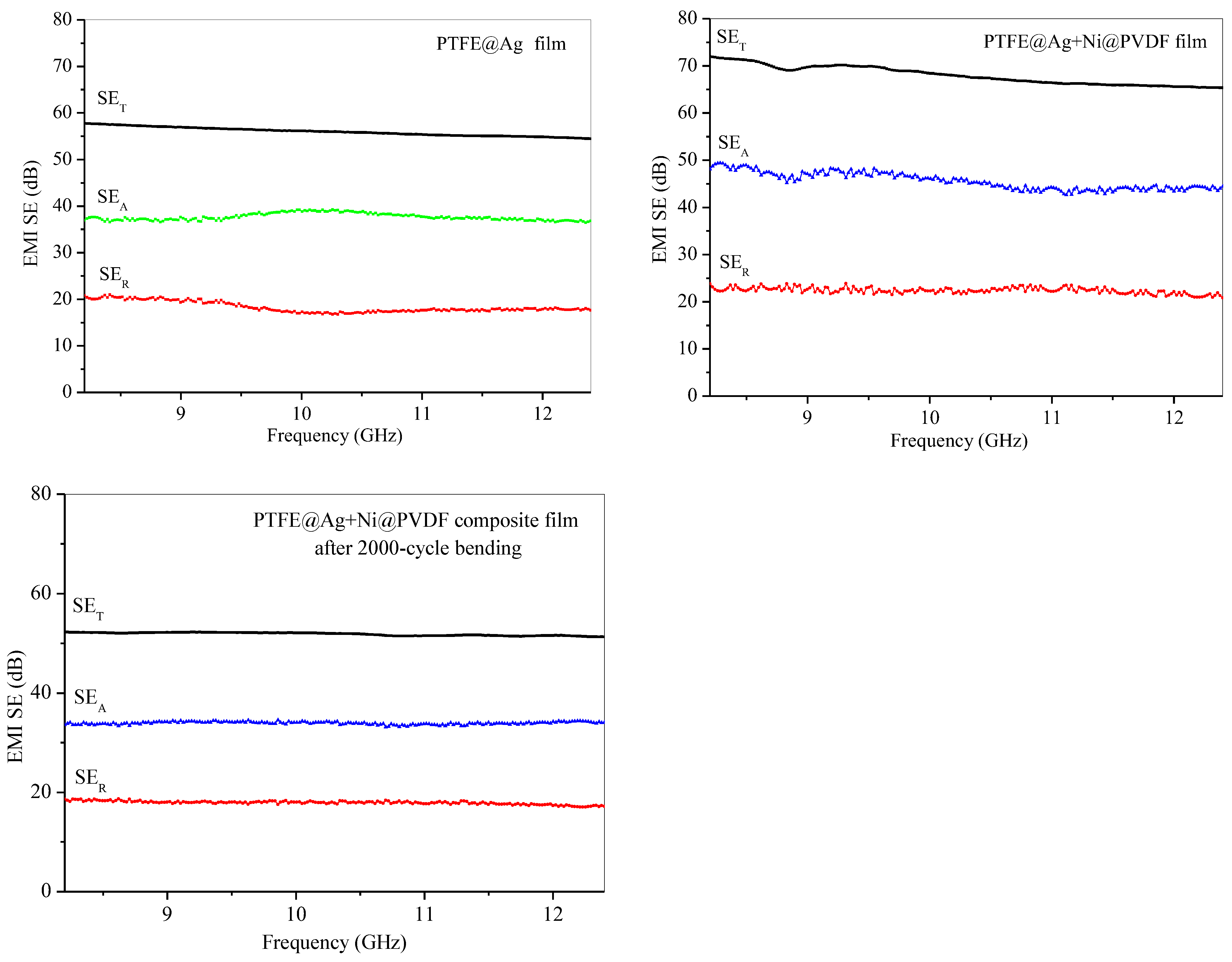
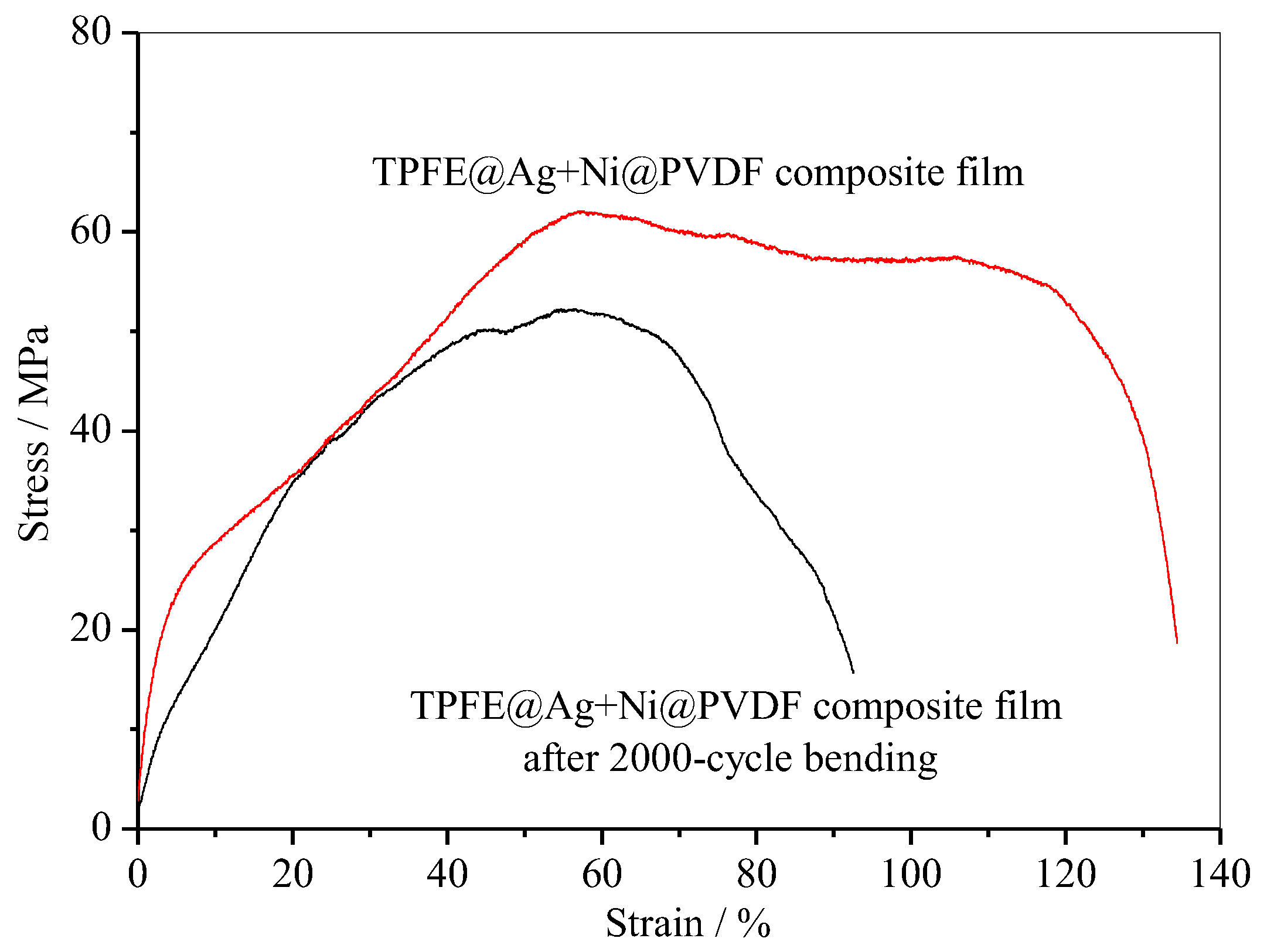
| Material | Conductivity (S/cm) | Thickness (mm) | EMI SE (dB) | Ref. |
|---|---|---|---|---|
| Ga-MXene/cellulose film | 390.0 | 0.060 | 52.80 | [1] |
| NWPU/PPy/AgNWs coating films | 1026.1 | 0.480 | 64.20 | [3] |
| EP/rGO/Ni-chainsx foams | 0.151 | — | 41.11 | [4] |
| MXene/jute composite | 1519.0 | 3.000 | 59.08 | [8] |
| PVDF-CNT-Graphene-NiCo chains composite films | 912.0 | 3.000 | 63.30 | [14] |
| EP/f-RGO/Ni-chains microcellular foam | ~10−1 | — | 40.82 | [17] |
| MXene/MrG composite membranes | 2281.0 | 0.018 | 89.10 | [19] |
| MXene/Galinstan composite films | 4955.0 | ~0.015 | 66.28 | [20] |
| graphene/AgNPs-coated CAFP | 4431.0 | 0.035 | 92.29 | [23] |
| EP/AgNW/TAGA | 595.7 | 4.000 | 84.01 | [24] |
| P@Ni-Co hybrid membrane | 1139.6 | 0.180 | 77.80 | [26] |
| PDA-Doped rGO/MWCNT composite | — | 0.082 | 47.60 | [33] |
| PTFE@Cu/Ni@PVDF composite films | 1117.6 | 0.080 | 57.16 | [35] |
| PTFE@Ag+Ni@PVDF composite films | 7507.5 | 0.080 | 69.03 | This work |
Disclaimer/Publisher’s Note: The statements, opinions and data contained in all publications are solely those of the individual author(s) and contributor(s) and not of MDPI and/or the editor(s). MDPI and/or the editor(s) disclaim responsibility for any injury to people or property resulting from any ideas, methods, instructions or products referred to in the content. |
© 2023 by the authors. Licensee MDPI, Basel, Switzerland. This article is an open access article distributed under the terms and conditions of the Creative Commons Attribution (CC BY) license (https://creativecommons.org/licenses/by/4.0/).
Share and Cite
Liu, H.; Huang, J.; Guo, B. Light Weight, Flexible and Ultrathin PTFE@Ag and Ni@PVDF Composite Film for High-Efficient Electromagnetic Interference Shielding. Materials 2023, 16, 4831. https://doi.org/10.3390/ma16134831
Liu H, Huang J, Guo B. Light Weight, Flexible and Ultrathin PTFE@Ag and Ni@PVDF Composite Film for High-Efficient Electromagnetic Interference Shielding. Materials. 2023; 16(13):4831. https://doi.org/10.3390/ma16134831
Chicago/Turabian StyleLiu, Hongbo, Jiajie Huang, and Bingzhi Guo. 2023. "Light Weight, Flexible and Ultrathin PTFE@Ag and Ni@PVDF Composite Film for High-Efficient Electromagnetic Interference Shielding" Materials 16, no. 13: 4831. https://doi.org/10.3390/ma16134831





